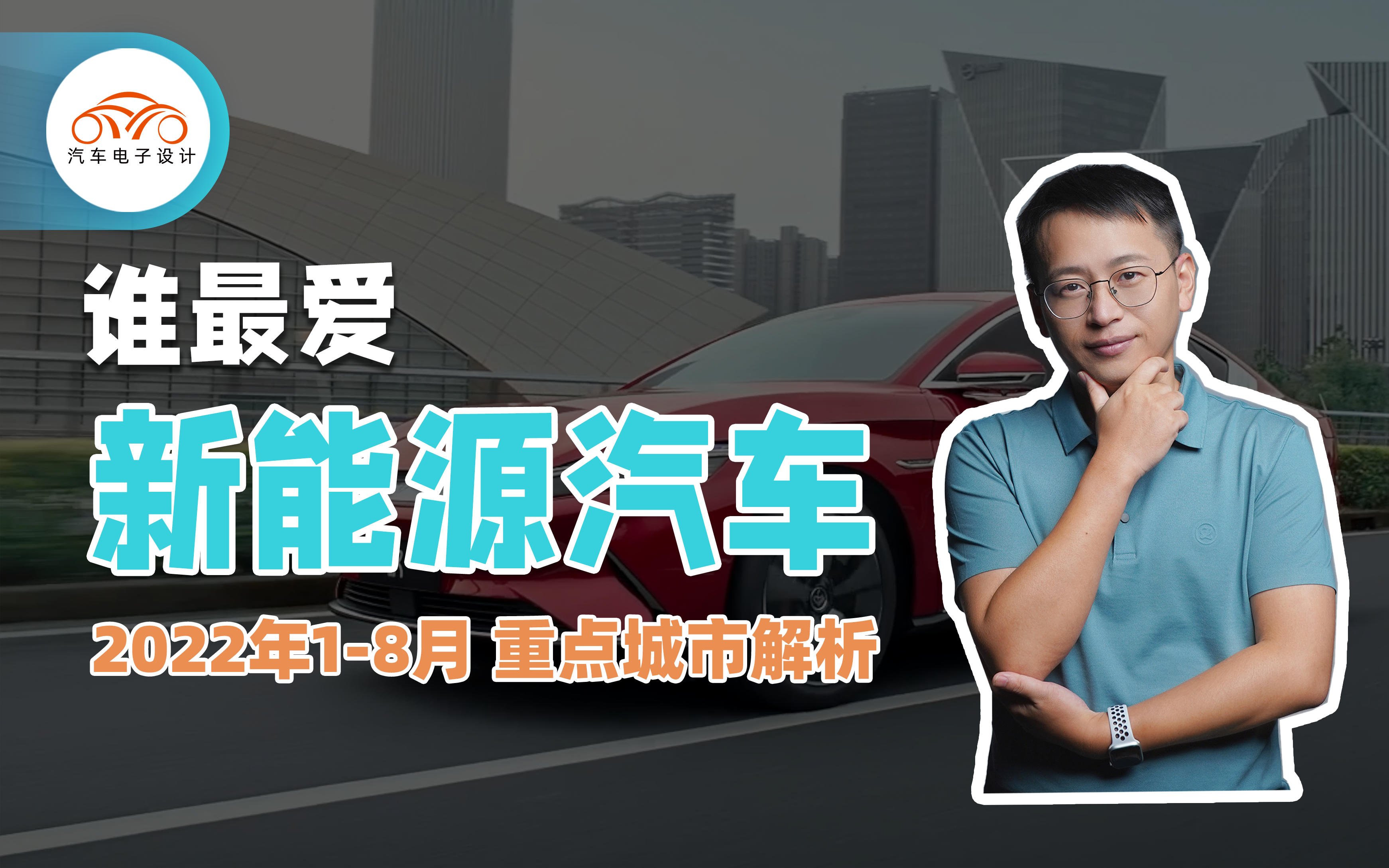City Rankings
Which are the top three cities with the highest sales of new energy vehicles?
In terms of absolute quantity, as of August of this year, three cities saw over 100,000 new energy vehicles sold:
-
Shanghai: 142,000
-
Shenzhen: 125,000
-
Hangzhou: 112,000
It is not surprising that Shanghai and Shenzhen are in the top three, due to strict license plate policies for gas cars and strong purchasing power, as well as new energy vehicles being key industries in these cities.
Hangzhou, despite implementing similar car purchase restrictions, has also made it into the top three. As a quasi-first-tier city, it is commendable that the enthusiasm for purchasing new energy vehicles in Hangzhou has pushed it into first place, and the Zhejiang provincial government’s determination to develop the new energy vehicle industry can be felt in the infrastructure development. As of the end of 2021, there were 23,400 public charging piles in Hangzhou’s public service areas, which makes it easy to travel by electric vehicle in the province, as charging facilities are relatively abundant even at the prefectural city level. A total of 188 high-speed service area charging stations have been put into operation across Zhejiang Province, with 1,052 high-speed charging ports.
Which of the top five cities is not a first-tier city?
Hangzhou is not a first-tier city and ranks third among the top five, after Chengdu and Guangzhou. Thus, the answer is that Beijing is not among the top five, but ranks sixth. This is not because the people of Beijing have a bias against new energy vehicles, but mainly because they are still subject to the restrictions of their Beijing license plates, with only 70,000 new energy vehicle quotas for 2022.
Which first-tier city has the highest penetration rate of new energy vehicles?
The answer is: Shenzhen.
Shenzhen was the first large city to break through the penetration rate of new energy vehicles in new car sales, with a penetration rate of 40%. The penetration rates of other top ten cities are around 30%.
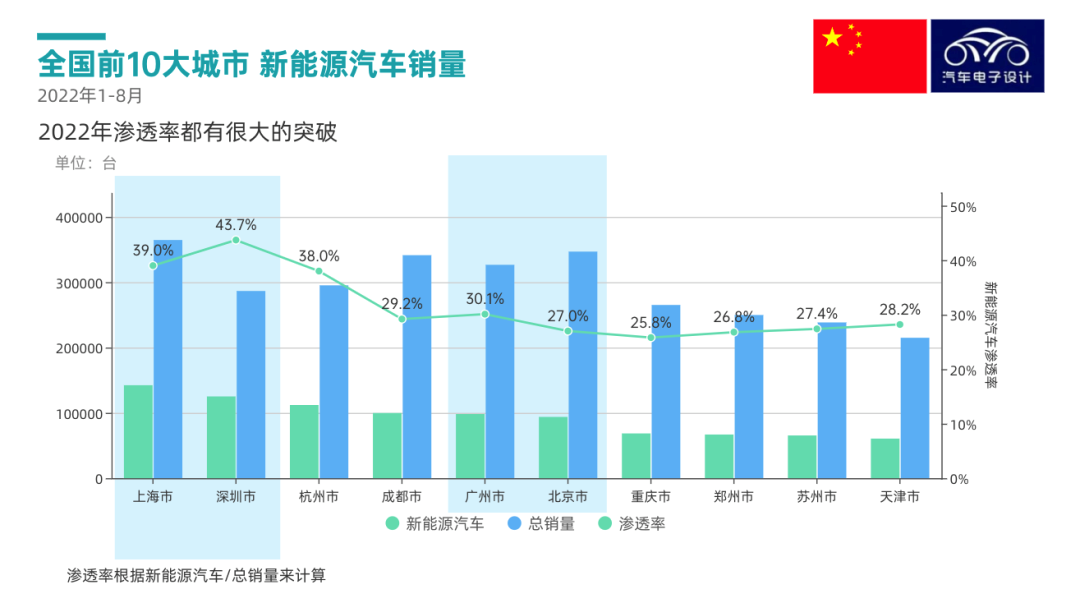
Per capita purchasing power of new energy vehicles
All the above data refers to the sales figures of new vehicles. However, when evaluating the popularity of new energy vehicles in a city, simply looking at sales is not accurate and is influenced directly by population size. Therefore, dividing sales figures by the number of permanent residents may be a more intuitive indicator. I selected the top 12 sales cities and made this calculation.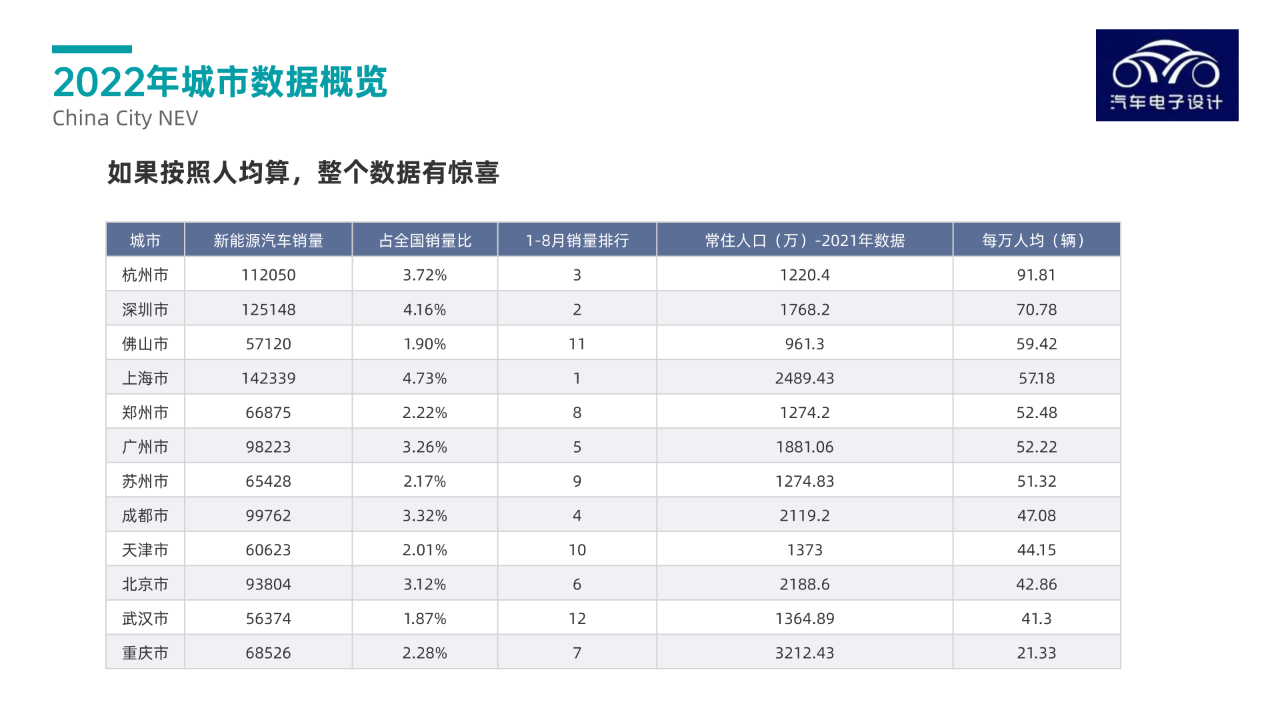
From the statistics (in the table above), it can be seen that Hangzhou, miraculously, has come out on top when it comes to the number of new energy vehicles purchased per ten thousand people in the first 8 months of this year. It seems that Hangzhou is truly a devotee of electric cars. Is this data an indication that the coders in Hangzhou are a good match for electric cars or is it simply because coders have more money to try out new things?
And then there’s another magical city: Foshan. It ranks third in the per capita ownership of new energy vehicles list. In fact, in the overall data for the first 8 months, Foshan did not even make it to the top ten, but upon closer inspection, it turns out that it’s not that people in Foshan don’t like electric cars, it’s just that there aren’t enough of them yet…

Who prefers pure electric vehicles and who prefers hybrid vehicles among the cities with higher sales?
-
The city that prefers pure electric vehicles the most: Beijing, with a proportion of 92%. This high proportion is obviously due to policy guidance – Beijing does not issue license plates for plug-in hybrids and extended-range electric vehicles.
-
Shanghai: Although Shanghai is one of the most friendly cities for plug-in hybrids, it cannot resist the full adoption of pure electric vehicles, which account for 68.73% of the market.
-
The city that prefers hybrid vehicles the most: Shenzhen. This is easy to imagine, as it is not only the hometown of BYD, but also the largest fan city of BYD.
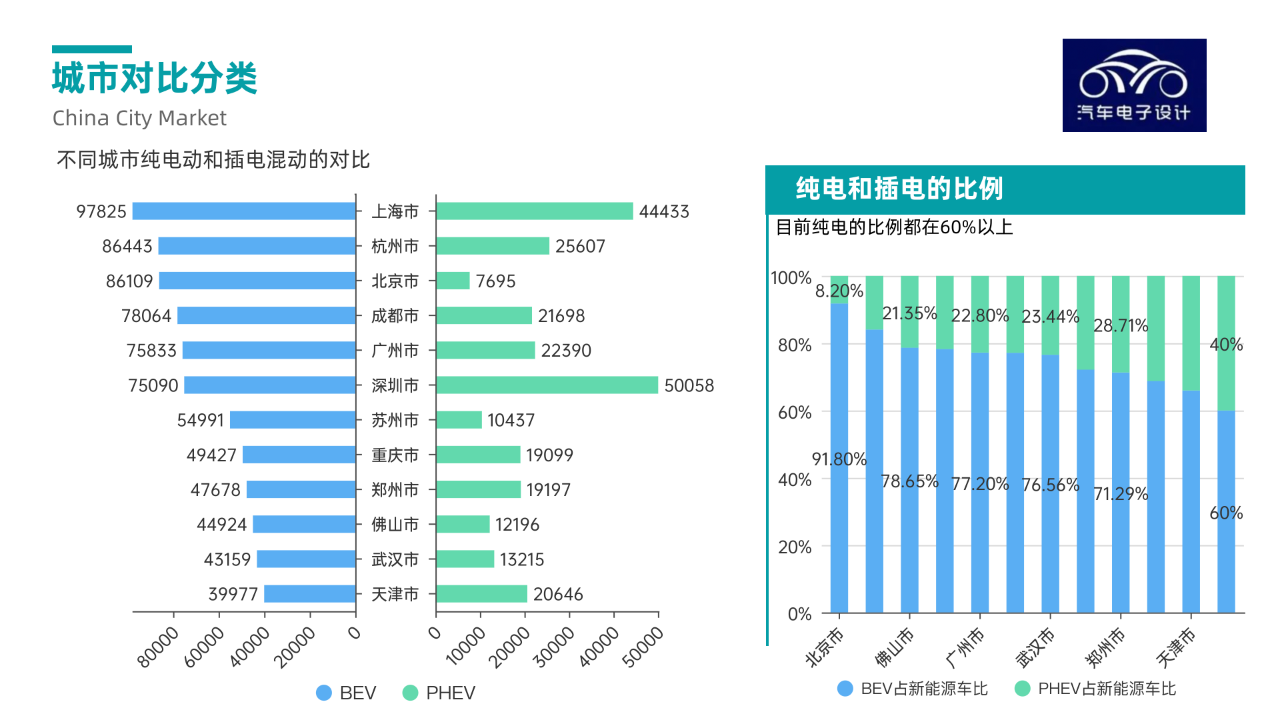
Preferences of different cities for new energy vehicle brands
Next, let us take a look at the brand preferences of first-tier cities (Beijing, Shanghai, Guangzhou and Shenzhen) for new energy vehicles.
After all, the brand preferences of first-tier cities have some reference value for predicting the positioning strategies of subsequent brands.

Beijing
The TOP5 brands that sell the most in Beijing are: BYD, Tesla, Volkswagen and BAIC.
BAIC, as the representative of domestic brands, has a good record of more than 8,000 vehicles sold, which is not bad, but this achievement can only be seen in Beijing and no other first-tier city has this brand in the top five.
Weichai Auto (a domestic new force) has not made it into the top five in Beijing.### Shanghai
The top 5 best-selling car models in Shanghai are BYD, Tesla, Roewe, Volkswagen, and Nio.
It’s amazing that BYD ranks first and sells nearly 40,000 vehicles, with a market share of 28%, which is quite impressive. Among plug-in hybrid models, BYD occupies 54% of the market, and the best-selling BYD model is the Song Plus, with nearly 10,000 units sold, followed by the Qin DM-i, with over 5,000 units sold.
As a local brand in Shanghai, Roewe only made it to the top five in the Shanghai area, which is not surprising.
The most popular pure electric vehicle in the Shanghai market is the Model Y, with 16,300 units sold, and with Tesla increasing production after October, there will be significant improvements. The second best-selling is the Tesla Model 3 with 6,400 units sold, and the third is the Roewe Ei5 with 5,500 units sold.
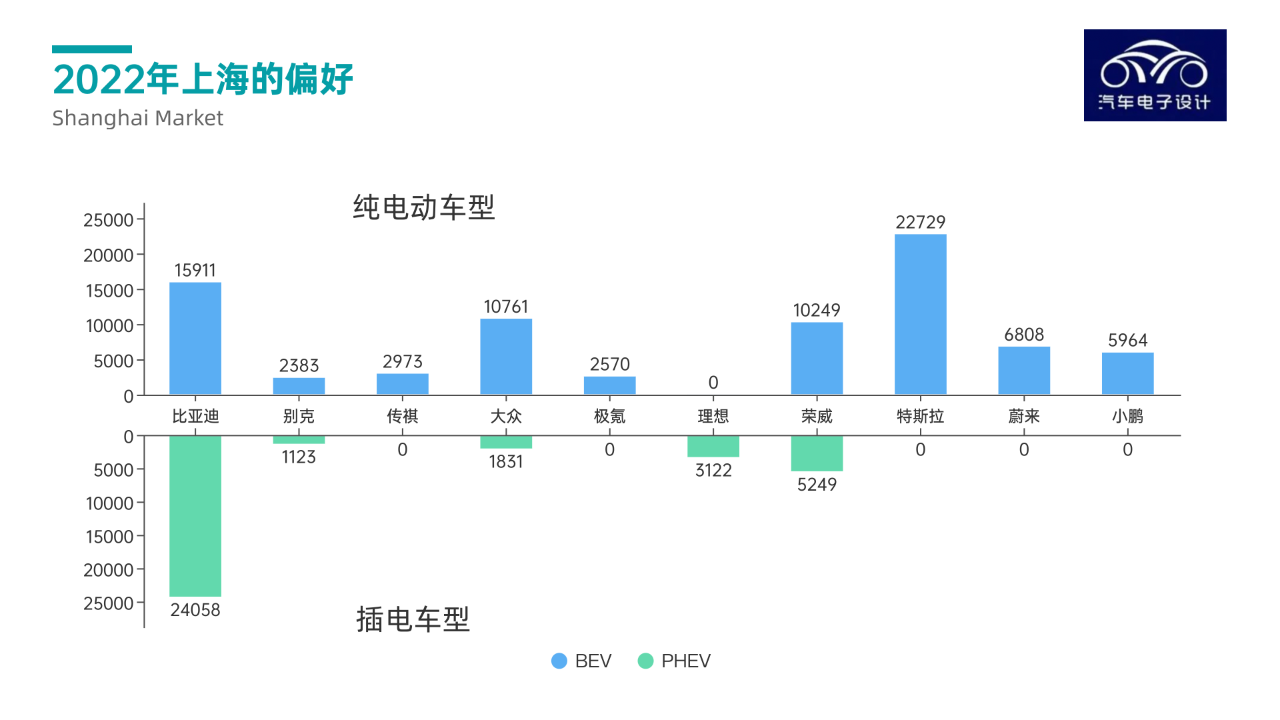
Guangzhou and Shenzhen
I have written an article exclusively about Shenzhen’s data before, so I will be talking about Guangzhou and Shenzhen together today: the preferences of the two cities are quite similar.

The absolute number of licensed electric vehicles in both cities is roughly the same, at around 75,000, and the difference is that Shenzhen is more inclined towards plug-in hybrids, with 50,000 units, while Guangzhou has only about half that, at 22,300 units.
Looking at the comparison between the two cities, these are the top 5 brands:
-
Guangzhou: BYD (25,500), EA (19,400), Tesla (9,095), XPeng (5,844), and Wuling (3,422)
-
Shenzhen: BYD (52,500), Tesla (15,100), EA (10,000), XPeng (4,469), and Volkswagen (3,957)
BYD ranks first, which is no surprise. Tesla and EA both made it into the top three. XPeng unfortunately did not make it to the top five in Beijing and Shanghai because they did not launch any new models in the first half of the year, but as a local brand, Guangzhou and Shenzhen people still have affection for XPeng.The fifth place in Guangzhou and Shenzhen is taken by Volkswagen and Wuling respectively. From this ranking, it seems that at least from January to August, the people of Guangzhou still prefer cost-effective options.
Among all-electric vehicles, the most popular models among the people of Guangzhou and Shenzhen are Model Y, Aion S, Aion Y, Han EV, and Model 3.
Plug-in hybrid models mainly include BYD, BYD (Song), BYD (Qin), BYD (Han), and BYD (Tang), as well as the Ideal ONE.

- As mentioned before, the electric vehicles per capita in Foshan rank in the top three, and their preferred models are similar to those of the people of Guangzhou.
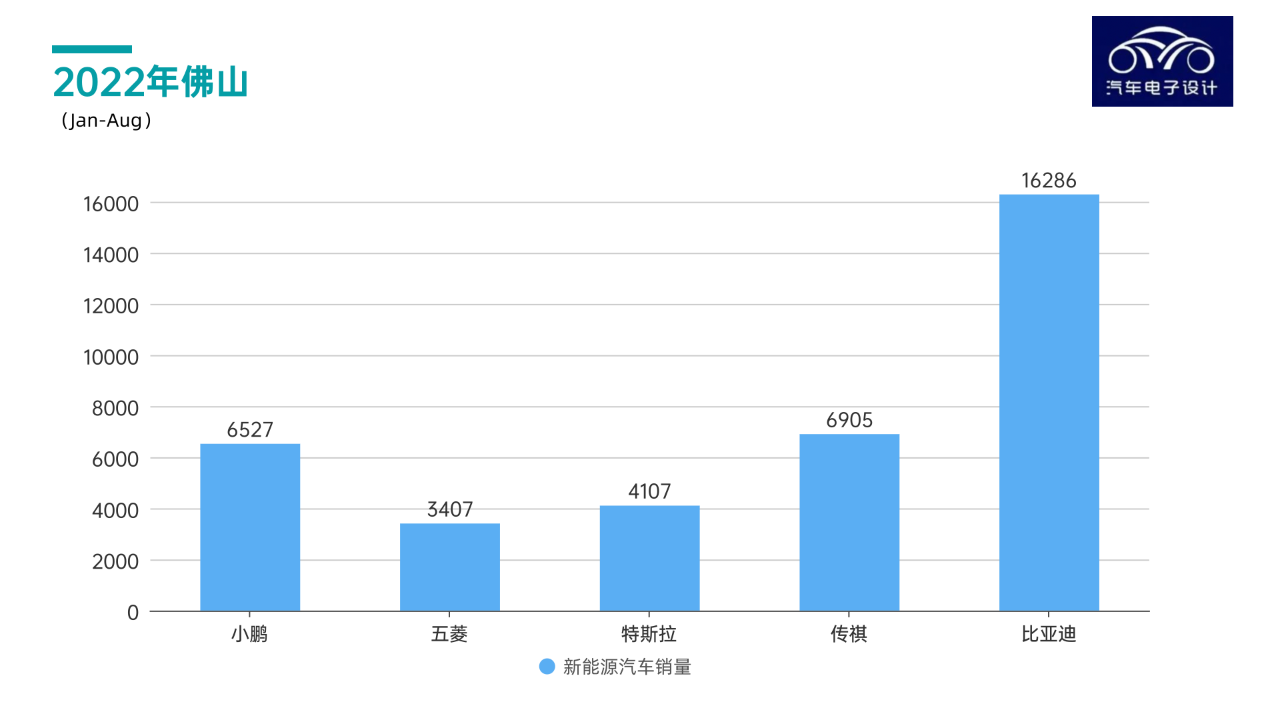
Ultimately, we can see that:
BYD has won in all four super first-tier cities of Beijing, Shanghai, Guangzhou, and Shenzhen this year. Although Tesla, which had the highest expectations last year, has lost its first place, it is still stably located in the second position in major cities. AEA, Volkswagen, and their cost-effective new models have attracted attention.
Similarly, Weima, which shone brightly last year, only has XPeng Motors remaining in the top five this year.

- If compared to second-tier cities, the results are not much different. The only difference is that BYD’s advantage of leading is even greater. Wuling remains the Wuling for the people of the country, Volkswagen is popular for its reputation in traditional vehicles, and XPeng Motors is the only remaining member among the local new forces.
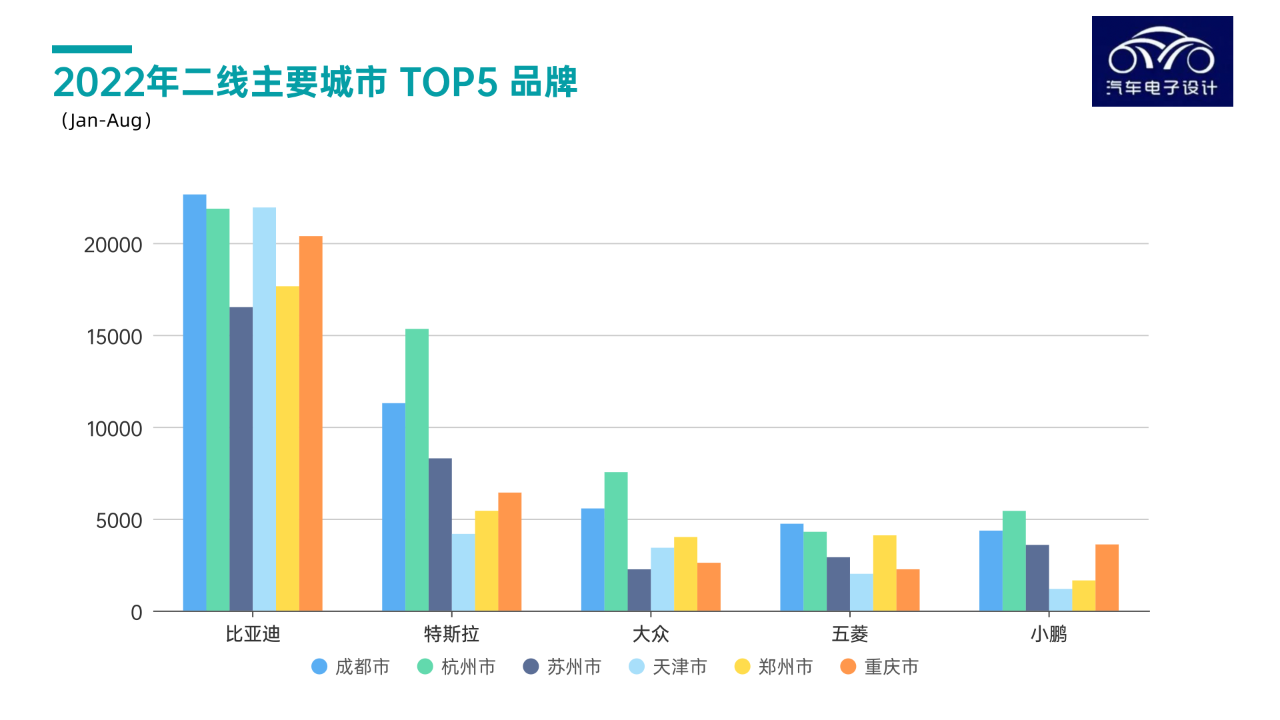
In summary: It is said that the new energy vehicle market is very competitive, and this data ranking shows the fierce competition. If you do not constantly innovate, you will be crushed underfoot. Last year was still a “newcomer”, but this year it has entered the “middle-aged crisis”.
In 2021, it was time for new forces to expand their territories in first-tier cities, and by 2022, it had evolved into old car companies stabilizing and expanding their market. The requirements for car companies in the second half of the new energy automotive competition are very high, from production capacity preparation to supply chain control.
This article is a translation by ChatGPT of a Chinese report from 42HOW. If you have any questions about it, please email bd@42how.com.
